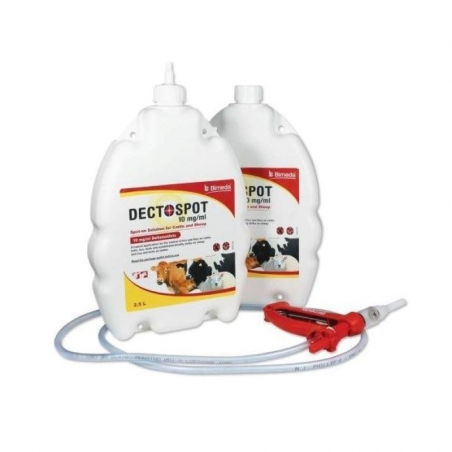


Prevention and treatment of infestations by various ectoparasites.

Prevention and treatment of infestations by the following ectoparasites:
In cattle: For the treatment and prevention of infestations by biting and sucking lice, including Bovicola bovis, Solenopotes capillatus, Linognathus vituli and Haematopinus eurysternus. Also as an adjunct in the treatment and prevention of infestations by biting flies and flies in general including Haematobia irritans, Stomoxys calcitrans, Musca species and Hydrotaea irritans.
In sheep: For the treatment and prevention of infestations by Ixodes ricinus ticks and lice (Linognathus ovillus, Bovicola ovis), melophages (Melophagus ovinus) and established cutaneous myiasis (usually Lucilia species).
In lambs: For the treatment and prevention of infestations by Ixodes ricinus ticks and by Bovicola ovis lice.
Active substances: Deltamethrin 10.0 mg
The deltamethrin molecule belongs to the family of synthetic pyrethroids. It is characterized by its insecticidal and acaricidal activity, acting by altering the permeability of sodium channel molecules causing hyperactivation, followed by paralysis (“knock-down” effect) with tremors and parasite mortality. Two physiological mechanisms are likely to contribute to resistance to deltamethrin: mutation of the molecular target of deltamethrin or genomic selection resulting in increased expression of the mitochondrial enzymes oxidase and esterase.
Posology and route of administration:
Continuous anointing.
Cattle: 100 mg of deltamethrin per animal, corresponding to 10 ml of veterinary medicine.
Sheep: 50 mg of deltamethrin per animal, corresponding to 5 ml of veterinary medicine.
The veterinary medicinal product should be applied without dilution between the animal's shoulder blades along the dorsal midline.
For the treatment and prevention of tick, melophage and lice infestations in sheep, the fleece must be removed and the veterinary medicine applied to the animal's skin. To obtain maximum effectiveness, it is advisable to:
The fly protection period lasts for 4 to 6 weeks.
Lice in cattle: One application will generally eradicate all lice. The complete elimination of all lice can take 4 to 5 weeks during which the lice hatch from the eggs and are killed. Very few lice can survive in a small minority of animals.
Melophages and lice in sheep: One application will reduce the incidence of an infestation by biting lice or melophages over a period of 4 to 6 weeks after treatment. The influence of climatic conditions on the duration of effectiveness has not been investigated. The length of the Musca species prevention period may vary.
The veterinary medicinal product must be applied using an appropriate application device:
An appropriate applicator must comply with the following specifications:
Because it is a veterinary medicinal product subject to medical prescription, we ask you to send it to the email:
[email protected]